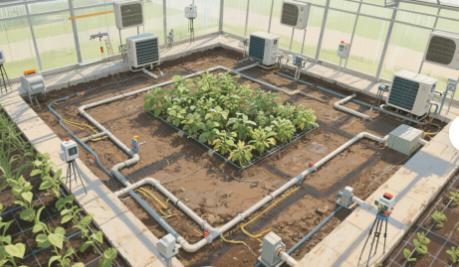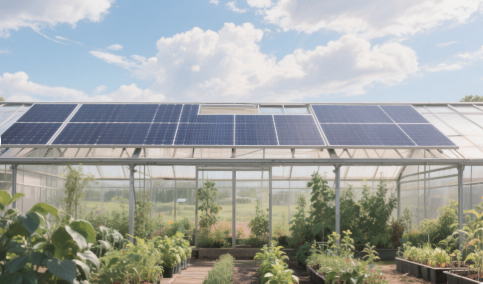Hey there, greenhouse enthusiasts! Are you ready to dive into the world of winter greenhouse insulation? Whether you're a seasoned grower or just starting out, keeping your plants cozy during the cold months is crucial. Let's explore some top-notch materials, smart design ideas, and energy-saving hacks to make sure your greenhouse stays warm and efficient. Ready to get started?
Choosing the Right Insulation Materials
When it comes to insulation, there are plenty of options to choose from. Let's break down a few popular ones:
Polystyrene Foam (EPS)
This material is super lightweight and strong, making it a great choice for insulation. It has a low thermal conductivity, which means it keeps the heat inside your greenhouse. For example, in the cold winters of the Northeast, using EPS can keep the inside temperature around 15°C, even when it's -20°C outside. Just remember, EPS can degrade in sunlight, so a protective coating is a must.
Polyurethane Foam (PU)
PU is like the luxury option of insulation materials. It has amazing thermal properties and can be applied on-site, filling every nook and cranny to create a seamless insulation layer. The downside? It's a bit pricey and requires good ventilation during installation to avoid those strong fumes.
Rock Wool
Rock wool is a tough, fire-resistant material that doesn't absorb much water. It's perfect for greenhouses near forests, offering both insulation and fire protection. However, it's not as strong as some other materials, so handle it with care to avoid damage.
Aerogel
Aerogel is the new kid on the block, and it's pretty amazing. It has incredibly low thermal conductivity and is super lightweight, making it easy to install. The catch? It's expensive. But if you're looking for top-of-the-line insulation, like at the Chengfei Greenhouse, it's worth the investment.
Smart Greenhouse Design for Better Insulation
Great insulation materials are just the start. The design of your greenhouse can make a huge difference too.

Greenhouse Shape
The shape of your greenhouse matters. Round or arched greenhouses have less surface area, which means less heat loss. In Canada, many greenhouses are arched, reducing heat loss by 15%. Plus, they can handle heavy snow loads without collapsing.
Wall Design
Your greenhouse walls are key to insulation. Using double-layered walls with insulation in between can boost performance. For example, filling walls with 10 cm of EPS can improve insulation by 30%. Reflective materials on the outside can also help by reflecting solar heat, keeping the walls' temperature stable.
Roof Design
The roof is a major spot for heat loss. Double-glazed windows with inert gases like argon can significantly reduce heat loss. For example, a greenhouse with double-glazed windows and argon saw a 40% reduction in heat loss. A roof slope of 20° - 30° is ideal for draining water and ensuring even light distribution.
Sealing
Good seals are essential to prevent air leaks. Use high-quality materials for doors and windows, and add weatherstripping to ensure a tight seal. Adjustable vents can also help control airflow, keeping heat inside when needed.

Energy-Saving Tips for a Warm Greenhouse
Insulation and design are important, but there are also some energy-saving tricks to keep your greenhouse warm and efficient.
Solar Power
Solar energy is a fantastic, renewable resource. Installing solar collectors on the south side of your greenhouse can convert sunlight into heat. For example, a greenhouse in Beijing saw a 5 - 8°C increase in daytime temperatures with solar collectors. Solar panels can also power your greenhouse's lights, fans, and irrigation systems, saving you money and reducing your carbon footprint.
Geothermal Heat Pumps
Geothermal heat pumps use the earth's natural heat to warm your greenhouse. They can significantly reduce heating costs and are environmentally friendly. For example, a greenhouse in the North using a geothermal system cut heating costs by 40%. Plus, they can cool your greenhouse in the summer, making them a versatile option.
Hot Air Furnaces and Thermal Curtains
Hot air furnaces are a common choice for heating greenhouses. Pair them with thermal curtains to distribute heat evenly and prevent heat loss. For example, the Chengfei Greenhouse uses a combination of hot air furnaces and thermal curtains to maintain a consistent temperature, ensuring plants thrive in the winter.
Wrapping Up
There you have it! With the right insulation materials, smart design choices, and energy-saving strategies, you can keep your greenhouse warm and cozy during the cold months. Your plants will thank you, and so will your wallet. If you have any questions or tips of your own, feel free to share them in the comments below.
Welcome to have a further discussion with us.
Email:Lark@cfgreenhouse.com
Phone:+86 19130604657
Post time: Jun-22-2025







 Click to Chat
Click to Chat